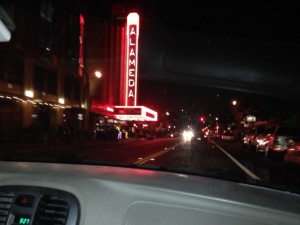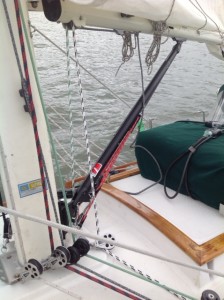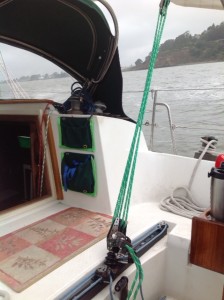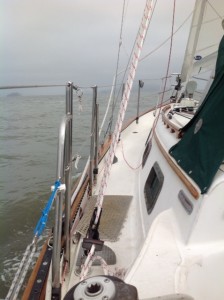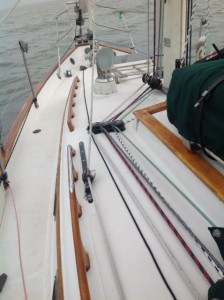We brought Cool Change over to Hansen Rigging in Alameda on February 23, 2014. There she sat in the water at their docks until May 9, when we motored her over to Svendsen’s Boat Yard. She was hauled out at Svendsen’s and not splashed again until May 27. One more delay caused us not to get her home until May 30. What a long haul!
But it was worth it. Well, I guess time will tell if all the upgrades we had done were worth the money, especially if we manage to live to our 90’s and are relegated to a diet of rice and beans because we spent all our money on Cool Change!
In the meantime, we visited Cool Change in Alameda as often as we could, and enjoyed getting to know the town of Alameda while we were at it. What a fun town! There were dozens of unique ethnic restaurants with great food at a fraction of the price of Sausalito, and we loved how everyone seemed to hang out on the streets at all hours and well into the evening. There were families of every ethnicity, young people, elderly, and all of us in between. It felt like a small town but with lots of people.
Glenn Hansen may not be known for working quickly, but he certainly cares about the quality of the work he does. He really thought carefully about the upgrades we wanted, and did such a fine job of designing new systems, and finding and installing the right equipment to do the jobs. Among other things, our rigging upgrades included a rigid boom vang.
He also mounted the whisker pole on the mast, and set up a system for deploying a spinnaker including a new halyard and bowsprit.
He changed out the mainsheet and traveler hardware for much more modern, user-friendly equipment that among other things, gives us much better advantage when trying to sheet in the main in a blow without a winch; he also ran extra control sheets to the cockpit to reef entirely from the cockpit, two lines for each reef (one for the control at the mast and one for the control at the aft end of the boom).
We love how Glenn changed out the running back hardware as well as rigging the running backs in such an ingenious way so as to enable deployment and release from the cockpit.
He also unstepped and restepped the mast, which resulted in a rig tuning, and replaced any other hardware that he identified as weak or failing. On top of all this, he added a clutch to our headsail furling line, reconfigured the top of the mast to allow more room, added a lightening preventer, and a dozen other things.
Glenn wrote a letter for insurance purposes afterwards that declared that Cool Change’s rigging is “ready and able for blue water/ocean cruising.” Woopie!
While Cool Change was at Hansen Rigging, Reliable Electronics installed all new electronics. We now have High Definition Color Radar; the latest chartplotter technology with touch-screen controls/manual override; fancy new controls for our autopilot that consider everything from wind speed to current to adjust course in order to keep on a heading; a new wind transducer; and a new depth/temperature/speed transducer that will give us very precise underwater images for finding fish, knowing the quality of the bottom of the sea for anchoring, etc., and tell us temperature of the water (we have never had that before), and speed through the water (I like that for comparison to Speed over Ground to help identify strength of current and leeway).
We also now have an AIS transponder. For those of you who are unfamiliar with this, all commercial ships must keep their location, speed and direction up to date on a system called AIS that is then transmitted via radio signals to every AIS receiver in the area. Many private boats like ours, also have this system. What it means is that we can see our our chartplotter, all ships in our area! So in the dark or in fog, we are not blind. RADAR helps for that too, and they should be used together, which we will. We upgraded our AIS system so that we not only receive, but also transmit, so those big container ships know that we are out there too!
All these systems and data are connected using the latest standards, and all the information can be programmed to read from the chartplotter screen or one of the two other instrument controls. All of this is at the helm, but can be read also on either of our ipads from the comfort of inside the cabin via a wireless connection. This is a MAJOR change from what we had before: a radar screen inside the cabin that was green on black, an iphone mounted at the helm with an app loaded for chartplotting, and some simple, 25-year old depth and wind speed instruments that worked only intermittently. Once we learn to use all of this, the biggest danger is relying TOO heavily on it, because it is all such fantastic stuff! A friend of ours lost his boat to the surf when his chartplotter software went berserk one night off an Hawaii island coast. The value of traditional ded-reckoning and celestial navigation has been so drilled into us as part of our sailing training that I hope we will not find ourselves ever in such a predicament, with or without our new electronics. But nevertheless, I am so glad we have it.
And then after all of these improvements, Cool Change moved to the boatyard for five new/replaced thru-hulls, a new bottom job, and a gorgeous hull polish (well, why not?). I also worked with the metal shop to have them design and install a frame for a bimini. I am making the canvas for the bimini (an awning over the helm).
In the meantime, we bought a beautiful watermaker at the boat show, which Rick has yet to install (it will be one of the last things because once it is installed, it has to be operated regularly). We also bought four flexible solar panels totalling 160 watts of energy, which I will attach with velcro to the bimini I am making and to our dodger. We also ordered an SSB radio and a new VHF radio, the installation of which, Rick is working on now.
All of this is making Cool Change the best dressed 31 foot boat in existence! And most importantly, she will be as safe as we can make her for ocean crossings when we are ready.
Speaking of getting ready for ocean crossings, both Rick and I are being recommended for passing our Ocean Passage Making Certification through U.S. Sailing. It is sort of the “Ph.d.” of the US Sailing training program. We spent almost a week out on the ocean with three other students being tested on being “skipper for the day/night”, celestial navigation, man overboard drills, navigation (without chartplotters or GPS), emergencies, and the like. Now all we need to do is take the written test and await the blessing of the Cel Nav guru at Club Nautique of our celestial navigation reduction accuracy, and we will be certified! What a relief. This training program has been several years in the making, and very grueling. We are as trained as we can be … now for our practical experience! September 1 will arrive soon enough!


